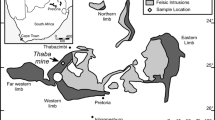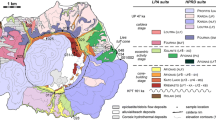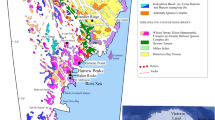Abstract
The layered cumulus rocks of the Marum ophiolite complex in northern Papua New Guinea range from highly magnesian dunite, wehrlite, and lherzolite through pyroxenite to norite-gabbro with minor anorthosite and ferronorite-gabbro near the top of the sequence. Most of the cumulates, particularly the gabbroic rocks, are characterised by recrystallised adcumulus textures and all intercumulus melt (mesostasis) has been expelled. Trends in the cumulate sequence from Mg-rich to more Fe-, Ca- and Al-rich compositions are consistent with the formation of the layered sequence by magmatic accumulation from mafic tholeiitic magmas with varying degrees of differentiation. The cumulates are characterised by extremely low levels of ‘incompatible’ elements (K, Ba, Rb, P, Zr, Nb, Hf, Y and REE) at all levels of differentiation. REE patterns are strongly depleted in LREE; HREE abundances range from ≦0.3 chondrites in peridotite to 3 x chondrites in the norite-gabbros.
The Marum cumulates resemble low-Ti peridotites and gabbros found in other orthopyroxene-bearing ophiolite sequences. The parent magmas of the Marum cumulates are inferred to have been strongly depleted in ‘incompatible’ trace elements (∼ 2,000 ppm Ti, ∼20 ppm Zr, 6–9 x chondrites HREE with LaN/SmN∼0.5). These abundances are lower than found in typical MORB and back-arc basin basalts or their picritic parents. The dissimilarity of trace element abundances of the inferred Marum parent magmas with MORB-type high-alumina olivine tholeiites supports the conclusion drawn previously from the petrology of the cumulates that the parent magmas to the Marum ophiolite were not of MORB composition but resembled the strongly depleted, Ni-rich magnesian olivine-poor tholeiites and quartz tholeiites of the Upper Pillow Lavas of the Troodos ophiolite. The Marum parent magmas are believed to have been formed by shallow melting of refractory peridotite, and are chemically and genetically distinct from the LREE-enriched high-Ti lavas (Tumu River basalts) which occur in faulted contact. The geochemical data do not permit unequivocal assignment of a tectonic environment for the formation of either the Tumu River basalts or the plutonic suite; their juxtaposition results from thrust emplacement.
Similar content being viewed by others
References
Arth JG (1976) Behaviour of trace element during magmatic processes — a summary of theoretical models and their applications. Res J US Geol Surv 4:41–47
Bryan WB, Thompson G, Frey FA, Dickey JS (1976) Inferred geological settings and differentiation in basalts from the Deep Sea Drilling Project. J Geophys Res 81:4285–4303
Chappell BW, Compston W, Arriens PA, Vernon MJ (1969) Rubidium and strontium determinations by X-ray fluorescence spectrometry and isotope dilution below the part per million level. Geochim Cosmochim Acta 33:1002–1006
Church WR, Riccio L (1977) Fractionation trends in the Bay of Islands ophiolite of Newfoundland: polycyclic cumulate sequences in ophiolites and their classification. Can J Earth Sci 14:1156–1165
Coleman RG, Donato MM (1979) Oceanic plagiogranite revisted. In: F Barker (ed) Trondhjemites, dacites, and related rocks. Elsevier, Amsterdam, pp 149–168
Coleman RG, Peterman ZE (1975) Oceanic plagiogranite. J Geophys Res 80:1099–1108
Davies HL (1971) Peridotite-gabbro-basalt complex in eastern Papua: an overthrust plate of oceanic mantle and crust. Aust Bur Miner Resour Bull 128
Davies HL (1980) Crustal structure and emplacement of ophiolite in southeastern Papua New Guinea. Colloques Internat CNRS No 272 — Association Mafiques Ultramafiques dans des Orogenes Grenoble 1977:17–33
Davies HL, Jaques AL (1983) Emplacement of ophiolite in Papua New Guinea. In: IG Gass, SJ Lippard, AW Shelton (eds) Ophiolites and oceanic lithosphere. Spec Publ Geol Soc London (in press)
Davies HL, Smith IEM (1971) Geology of Eastern Papua. Geol Soc Am Bull 82:3299–3312
Dietrich V, Emmermann R, Oberhänsli R, Puchelt H (1978) Geochemistry of basaltic and gabbroic rocks from the West Mariana Basin and Mariana Trench. Earth Planet Sci Lett 39:127–144
Dostal J, Muecke GK (1978) Trace element geochemistry of the peridotite-gabbro-basalt suite from DSDP Leg 37. Earth Planet Sci Lett 40:415–422
Duncan RA, Green DH (1980) The role of multistage melting in the formation of oceanic crust. Geology 8:22–26
Frey FA, Bryan WB, Thompson G (1974) Atlantic ocean floor: geochemistry and petrology of basalts from Legs 2 and 3 of the Deep Sea Drilling Project. J Geophys Res 79:5507–5527
Frey FA, Dickey JS Jnr, Thompson G, Bryan WB, Davies HL (1980) Evidence for heterogeneous primary MORB and mantle sources, NW Indian Ocean. Contrib Mineral Petrol 74:387–402
Frey FA, Green DH, Roy SD (1978) Integrated models of basalt petrogenesis: a study of quartz tholeiites to olivine melilitites from S.E. Australia utilising geochemical and experimental data. J Petrol 19:463–513
Gerlach DC, Leeman WP, Ave'Lallemant HG (1981) Petrology and geochemistry of plagiogranite in the Canyon Mountain Ophiolite, Oregon. Contrib Mineral Petrol 77:82–92
Gill JB (1976) Composition and age of the Lau basin and ridge volcanic rocks: implications for evolution of an interarc basin and remnant arc. Geol Soc Am Bull 87:1384–1395
Green DH, Hibberson WO, Jaques AL (1979) Petrogenesis of midocean ridge basalts. In: MW McElhinney (ed) The Earth: Its origin, structure and evolution. Academic Press, London, pp 265–295
Hart SR, Glassley WE, Karig DE (1972) Basalts and sea-floor spreading behind the Mariana Island Arc. Earth Planet Sci Lett 15:12–18
Haskin LA, Korotev RL (1977) Test of a model for trace element partition during closed-system solidification of a silicate liquid. Geochim Cosmochim Acta 41:921–939
Hawkins JW (1976) Petrology and geochemistry of basaltic rocks of the Lau Basin. Earth Planet Sci Lett 28:283–297
Hawkins JW (1977) Petrologic and geochemical characteristics of marginal basin basalts. In: M Talwani, WE Pitman III (eds) Island arcs, deep sea trenchs and back-arc basins. Am Geophys Union, Washington, pp 355–365
Hickey RL, Frey FA (1982) Geochemical characteristics of boninite series volcanics: implications for their source. Earth Planet Sci Lett (in press)
Hodges FN, Papike JJ (1976) DSDP Site 334: magmatic cumulates from oceanic layer 3. J Geophys Res 81: 4135–4151
Hopson CA, Frano CJ (1977) Igneous history of the Point Sal ophiolite, southern California. In: North American ophiolites. Oregon Dept Geol Miner Ind Bull 95:161–183
Irving AJ (1978) A review of experimental studies of crystal/liquid trace element partitioning. Geochim Cosmochim Acta 42:743–770
Jakeš P, Gill J (1970) Rare earth elements and the island-arc tholeiitic series. Earth Planet Sci Lett 9:17–28
Jaques AL (1980) Mineral analyses and rock descriptions for cumulate peridotites and gabbros from the Marum ophiolite complex, northern Papua New Guinea. Aust Bur Miner Resour Record 1980/53, BMR Microform MF146
Jaques AL (1981) Petrology and petrogenesis of cumulate peridotites and gabbros from the Marum ophiolite complex, northern Papua New Guinea. J Petrol 22:1–40
Jaques AL, Ophiolites of Papua New Guinea. In: N Bogdanov (ed) IGCP Project 39 Ophiolites, submitted for publication (in press)
Jaques AL, Chappell BW (1980) Petrology and trace element geochemistry of the Papuan Ultramafic Belt. Contrib Mineral Petrol 75:55–70
Jaques AL, Chappell BW, Taylor SR (1978) Geochemistry of LIL-element enriched tholeiites from the Marum ophiolite complex, northern Papua New Guinea. BMR J Aust Geol Geophys 3:297–310
Jaques AL, Robinson GP (1977) The continent/island-arc collision in northern Papua New Guinea. BMR J Aust Geol Geophys 2:289–303
Kay RW, Senechal RG (1976) The rare earth chemistry of the Troodos ophiolite complex. J Geophys Res 81:964–970
Kiss K (1977) Rapid potentiometric determination of the iron oxidation state in silicates. Analytica Chim Acta 89:303–314
Marsh NG, Saunders AD, Tarney J, Dick HJB (1980) Geochemistry of basalts from the Shikoku and Daito Basins, Deep Sea Drilling Project Leg 58. In: G de Vries Klein, K Kobayashi et al. (eds) Initial Rep Deep Sea Drilling Project 58. US Government Printing Office, Washington, pp 805–842
Masuda A, Jibiki H (1973) Rare-earth patterns of mid-Atlantic Ridge gabbros: continental nature. Geochem J 7:55–65
Mattey DP, Marsh NG, Tarney J (1980) The geochemistry, mineralogy, and petrology of basalts from the West Philippine and Parece Vela Basins and from the Palau-Kyushu and West Mariana Ridges, Deep Sea Drilling Project Leg 59. In: L Kroenke, R Scott et al. (eds) Initial Rep Deep Sea Drilling Project 59. US Government Printing Office, Washington, pp 753–800
Miyashiro A (1973) The Troodos ophiolitic complex was probably formed in an island arc. Earth Planet Sci Lett 19:218–224
Montigny R, Bougalt H, Bottinga Y, Allègre CJ (1973) Trace element geochemistry and genesis of the Pindos ophiolite suite. Geochim Cosmochim Acta 37:2135–2147
Moores EM (1969) Petrology and structure of the Vourinos ophiolitic complex, northern Greece. Geol Soc Am Spec Paper 118:1–74
Moores EM, Vine FJ (1971) Troodos Massif, Cyprus and other ophiolites as oceanic crust: evaluation and implications. Phil Trans Roy Soc Lond A 268:443–466
Nicholls IA (1974) A direct fusion method of preparing silicate glasses for energy dispersive electron microprobe analysis. Chem Geol 14:141–157
Norrish K, Chappell BW (1977) X-ray fluorescence spectrometry. In: J Zussman (ed) Physical methods in determinative mineralogy. Academic Press, London, pp 201–272
Pallister JS, Knight RJ (1981) Rare-earth element geochemistry of the Samail ophiolite near Ibra, Oman. J Geophys Res 86:2673–2697
Pearce JA (1975) Basalt geochemistry used to investigate past tectonic environments on Cyprus. Tectonophys 25:41–67
Pearce JA, Norry MJ (1979) Petrogenetic implications of Ti, Zr, Y and Nb variations in volcanic rocks. Contrib Mineral Petrol 69:33–47
Perfit MR, Gust DA, Bence AE, Arculus RJ, Taylor SR (1980) Chemical characteristics of island-arc basalts: implications for mantle sources. Chem Geol 30:227–256
Rhodes JM, Bence AE (1981) Ocean-floor basaltic volcanism. In: Basaltic Volcanism on the Terrestrial Planets. Lunar & Planetary Science Institute, Houston, Texas, Section 1.2.5, pp 132–160
Robertson AHF, Woodcock NH (1979) Tectonic setting of the Troodos massif in the eastern Mediterranean. In: A Panayiotou (ed) Ophiolites, Proceedings of the International Ophiolite Symposium, Cyprus 1979. Geol Surv Dept, Nicosia, pp 36–49
Roeder PE, Emslie RF (1970) Olivine-liquid equilibrium. Contrib Mineral Petrol 29:275–289
Saunders AD, Tarney J (1979) The geochemistry of basalts from a back-arc spreading centre in the East Scotia Sea. Geochim Cosmochim Acta 43:555–572
Saunders AD, Tarney J, Marsh NG, Wood DA (1979) Ophiolites as oceanic crust or marginal basin crust: A geochemical approach. In: A Panayiotou (ed) Ophiolites, Proceedings of the International Ophiolite Symposium, Cyprus 1979. Geol Surv Dept, Nicosia, pp 193–204
Saunders AD, Tarney J, Stern C, Dalziel IWD (1979) Geochemistry of Mesozoic marginal basin floor igneous rocks from southern Chile. Geol Soc Am Bull 90:237–258
Serri G (1981) The petrochemistry of ophiolite gabbroic complexes: a key for the classification of ophiolites into low-Ti and high-Ti types. Earth Planet Sci Lett 52:203–212
Serri G, Saitta M (1980) Fractionation trends of the gabbroic complexes from high-Ti and low-Ti ophiolites and the crust of major oceanic basins: a comparison. Ophioliti 5:241–264
Simonian KO, Gass IG (1978) Arakapas fault belt, Cyprus: a fossil transform fault. Geol Soc Am Bull 89:1220–1230
Smewing JD, Simonian KO, Gass IG (1975) Metabasalts from the Troodos massif, Cyprus: genetic implications deduced from petrography and trace element geochemistry. Contrib Mineral Petrol 51:49–64
Smewing JD, Potts PJ (1976) Rare-earth abundances in basalts and metabasalts from the Troodos massif, Cyprus. Contrib Mineral Petrol 57:245–258
Suen CJ, Frey FA, Malpas J (1979) Bay of Islands ophiolite suite, Newfoundland: Petrologic and geochemical characteristics with emphasis on rare-earth element geochemistry. Earth Planet Sci Lett 45:337–348
Sun S-S, Nesbitt RW (1978) Chemical regularities and genetic significance of ophiolitic basalts. Geology 6:689–693
Sun S-S, Nesbitt RW, Sharaskin AY (1979) Geochemical characteristics of mid-ocean ridge basalts. Earth Planet Sci Lett 44:119–138
Taylor SR, Gorton MP (1977) Geochemical application of spark source mass spectrography — III. Element sensitivity, precision and accuracy. Geochim Cosmochim Acta 41:1375–1380
Weaver SD, Saunders AD, Pankhurst RJ, Tarney J (1979) A geochemical study of magmatism associated with the initial stages of back-arc spreading. Contrib Mineral Petrol 68:151–169
Zonenshain LP, Kuzmin ML (1978) The Khan-Taishir ophiolite complex of western Mongolia, its petrology, origin and comparison with other ophiolite complexes. Contrib Mineral Petrol 65:95–109
Author information
Authors and Affiliations
Rights and permissions
About this article
Cite this article
Jaques, A.L., Chappell, B.W. & Taylor, S.R. Geochemistry of cumulus peridotites and gabbros from the Marum ophiolite complex, northern Papua New Guinea. Contr. Mineral. and Petrol. 82, 154–164 (1983). https://doi.org/10.1007/BF01166610
Received:
Accepted:
Issue Date:
DOI: https://doi.org/10.1007/BF01166610




